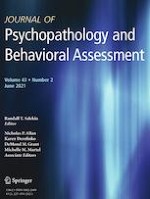29-05-2020
Evaluation of the Self-Report Inventory of Callous-Unemotional Traits in a Sample of Urban Middle School Students: a Multidimensional Rasch Analysis
Gepubliceerd in: Journal of Psychopathology and Behavioral Assessment | Uitgave 2/2021
Log in om toegang te krijgenAbstract
Callous-Unemotional (CU) traits are characterized by limited empathy, lack of guilt, and callous use of others. The Inventory of Callous Unemotional Traits (ICU) is considered one of the most common measures of CU traits; however, psychometric properties of the ICU remain a topic of debate. The present study applied multidimensional item response theory (MIRT) to compare structural models of the ICU. The sample was composed of primarily African American (82%) urban, middle-school youth. We employed a partial credit model to compare 8 models, including 24-, 22-, and 18-item versions. Consistent with previous psychometric evaluations of the ICU among ethnic minority samples, model fit indices indicated that the 18-item, two-factor ICU structures best fit our data. These findings have important clinical implications, as they suggest that the standard three-factor structure of the ICU may not be the most appropriate when assessing ethnic minority youth.
